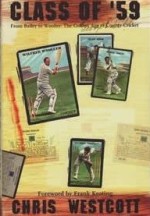Class of 59
David Taylor |Published: 1999
Pages: 282
Author: Westcott, Chris
Publisher: Mainstream Publishing
Rating: 4 stars

I bought this book from a dealer at Kent’s ground more than a year ago, but because of other demands on my time didn’t get round to reading it for several months. Once I did I was hooked. I should say at the outset I know nothing about the author. On the inside back page it says that at the time of publication he was working on a biography of Sonny Ramadhin, but I don’t know if that ever saw the light of day. Pictorial cards of cricketers have always been popular with collectors, and in 1959 the A & BC company produced a set of 48 of the leading county cricketers of the time. Westcott has tracked down all of them, or in the case of those deceased, their widows or next of kin, and interviewed them. Happily the majority were still alive in 1999 and most of those are with us to this day.
In 1959 English cricket was at something of a crossroads. The postwar boom that saw the record-breaking feats of Compton and Edrich, the tour of Bradman’s Invincibles and the recovery of the Ashes in Coronation Year of 1953 was at an end. There was no great enthusiasm from the public when England beat New Zealand 4-0 in 1958 and India 5-0 the following year, as in the interim the Ashes had been once again surrendered. Crowds at county games were well down from the beginning of the decade and clubs were losing money. The solution, of course, was to be found in limited-overs cricket, and, later, an injection of overseas stars.
Each of the players interviewed tells us what he was doing in 1959 and how his career panned out after that. Of course, some were already at the end of the line in playing terms, such as 44-year-old Colin McCool and Roy Tattersall, 37, who was left out of his own benefit match. Younger players such as Don Shepherd and Brian Taylor managed to play on into the 1970s. There is an assortment of Test stars and relatively obscure county players in the selection: Alec Bedser and Godfrey Evans need no introduction, while Brian Boshier and John Pretlove are not so well remembered today. The omission of some of the leading players such as Peter May, Colin Cowdrey and Tom Graveney is difficult to understand.
The reminiscences of the old players are almost without exception fascinating to read. Most of them made very little money from the game, but there seems to be little bitterness or jealousy of modern players. Westcott himself seems to be more editor than writer, as the players (or their widows) tell their own story. On only a handful of occasions, as with Evans for instance, is it left to him to reprise the player’s career. Each of them also chooses a memorable match, with its scorecard reproduced in full, and their ‘proudest moment’ which often entailed being capped by England or their county. The amount written by the players varies considerably: Eric Bedser was content with a single paragraph about himself, while Fred Trueman, as you might expect, had rather more to say, but managed to keep his contribution to around six pages – or perhaps it was edited to that length.
Without doubt this will appeal more to the older reader. There is a big market for books of a nostalgic nature and those who’ve enjoyed the work of Stephen Chalke will certainly like this one as well. Although it didn’t make much of an impact at the time it seems to be quite easy to find on the internet, and I would certainly recommend it to anyone who wants to be taken back to the England of fifty years ago.






Leave a comment